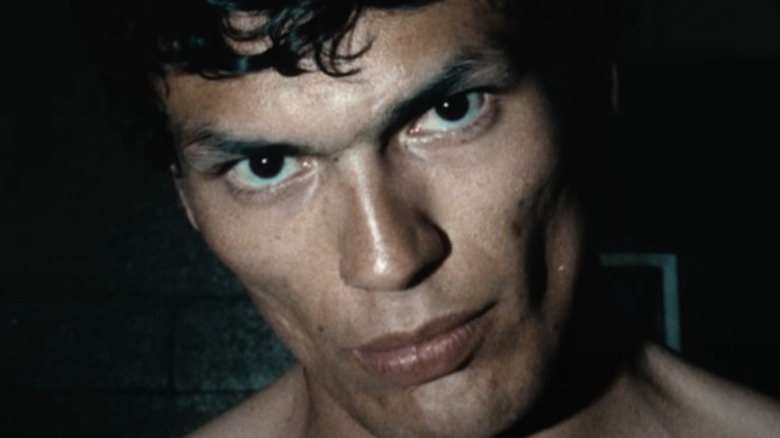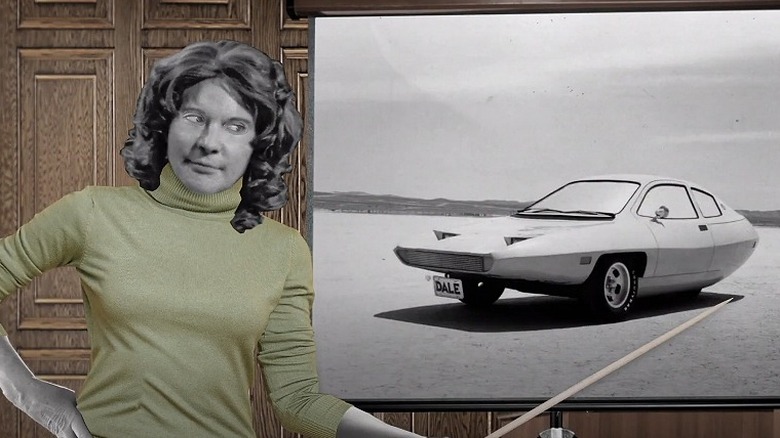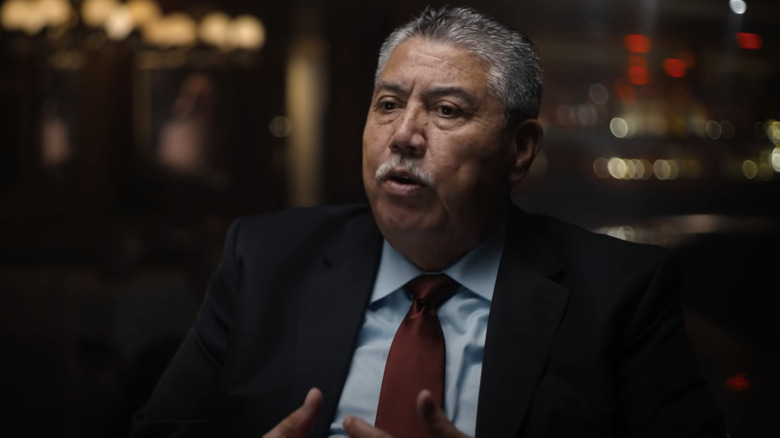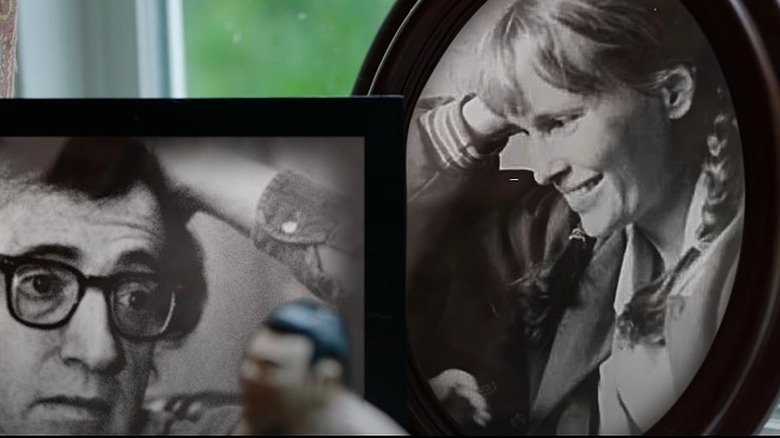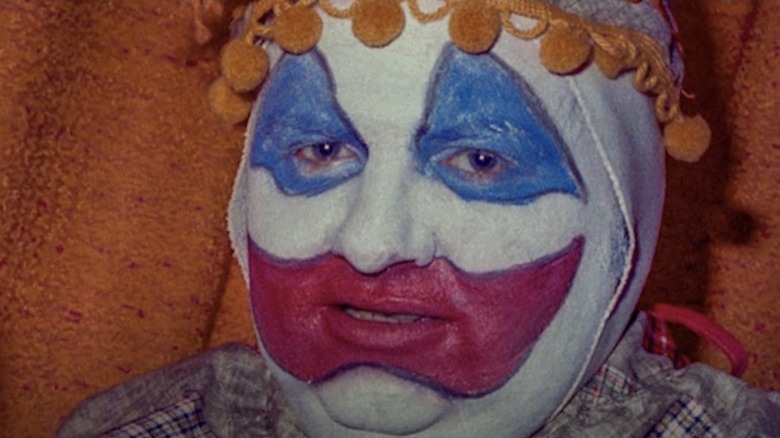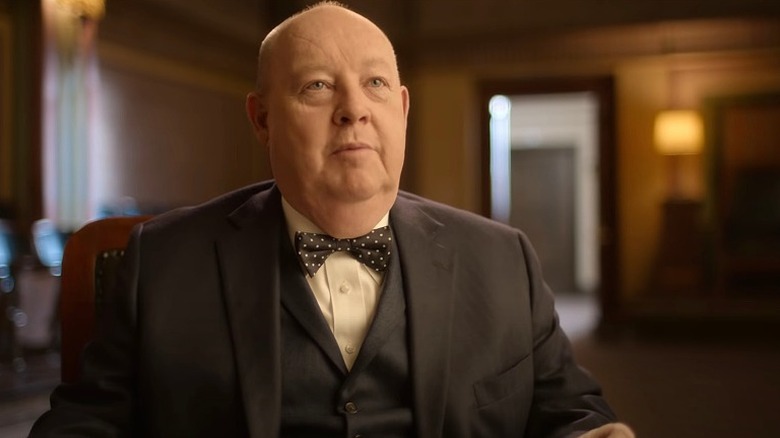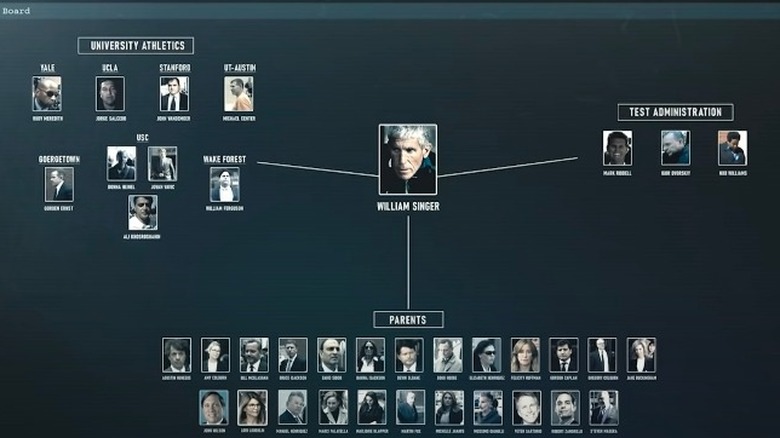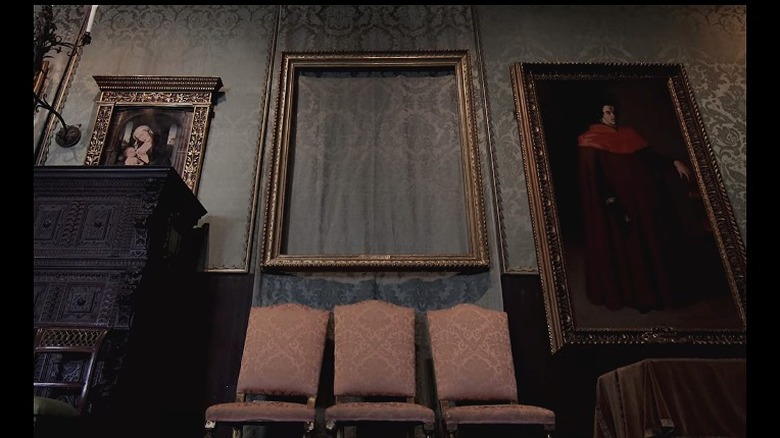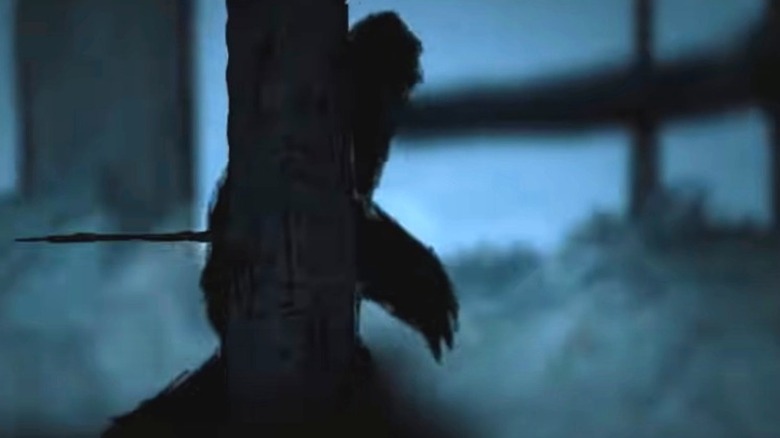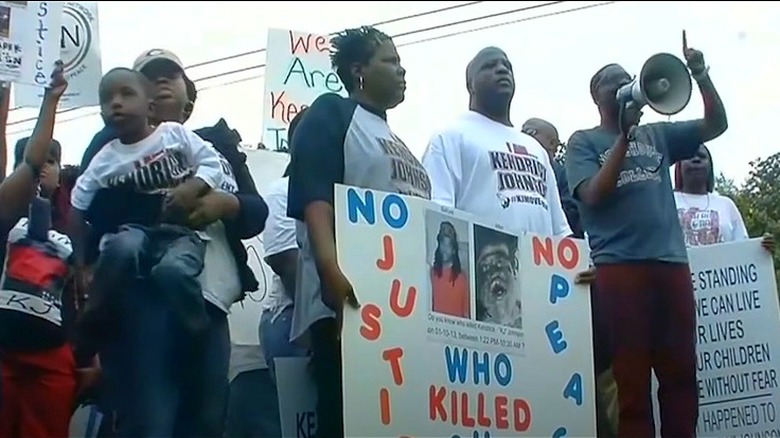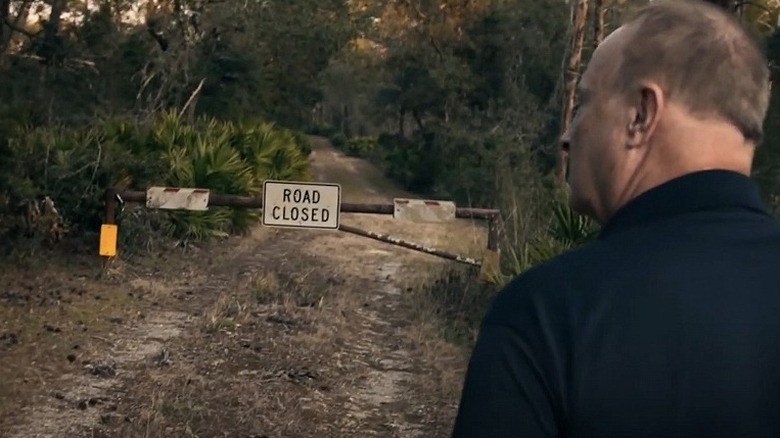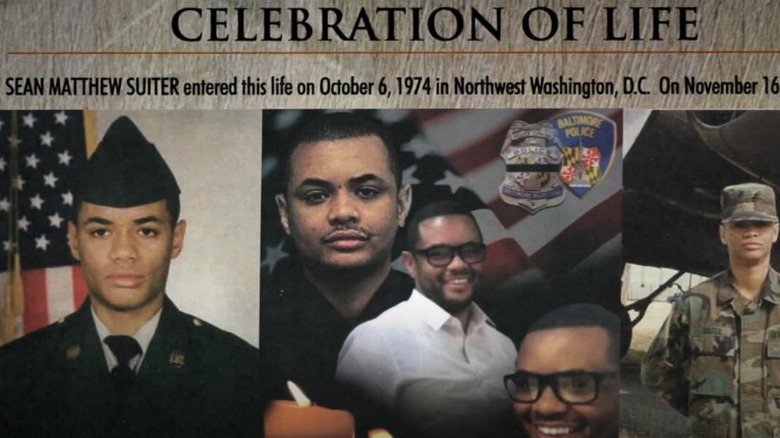The Best True Crime Documentaries Of 2021
From books to podcasts to TV miniseries, true crime documentaries continue to engage audiences around the globe. Although Variety reports that Netflix, which came to all but define the genre with its hit 2015 docuseries "Making a Murderer," saw an overall drop in ratings for their true crime offerings in 2021, the popularity of the genre persists. As noted by Rotten Tomatoes, "today, instead of mega-popular TV newsmagazines like 'Dateline' and other shows holding down the true-crime fort, we also have podcasts, streaming services, and even entire networks devoted to in-depth reporting on real-life cases ... the trend isn't slowing." In 2021, along with Netflix, which dominated lists of the best-reviewed series, streaming services HBO Max, Amazon, Peacock, and Hulu have contributed noteworthy true crime documentaries.
The crimes featured in 2021 documentaries run the gamut from fraud to serial murder, art theft to sexual abuse. Spotlighted are both criminals — con artists, serial killers, drug dealers, and robbers — and their investigative nemeses — detectives, journalists, and justice-seeking family members. Some stories are historical, looking back on infamous crimes or killers, while others attempt to shine a light on unsolved cases. Many look beyond the misdeeds themselves to the social realities that either made the crimes possible or, on the other end, made their solution impossible. Surrounding the stories are questions of race, sexual orientation, economic inequality, and feminism. All are entertaining, illuminating, or heart wrenching; in some cases, they're all three.
'The Lady and the Dale'
Chances are, before the release of "The Lady and the Dale," you'd never heard of the Twentieth Century Motor Car Corporation, its owner, Elizabeth Carmichael, or its singular model vehicle, the Dale. Fortunately, HBO's four-part series, produced by the Duplass Brothers and directed by Zachary Drucker and Nick Cammilleri, fills us in on this fascinating bit of 1970s true crime history. Ultimately found guilty of counterfeiting and fraud, Carmichael was a consummate con artist and salesperson, who also happened to be transgender. According to Oprah Daily, the six-foot would-be entrepreneur spun fanciful stories about her tomboy, farm-girl childhood and her life as a widowed mother of five. In truth, the three-wheeled Dale, which Carmichael touted to investors as a gas-saving wonder, had never been driven successfully, and Carmichael had spent her first 45 years as a thrice-divorced man and fraudster.
While the outrageousness of Carmichael and her schemes are engaging in and of themselves, "The Lady and the Dale" goes further by framing her criminal behavior in a homophobic social context. In its review, The New York Times praises the series as "a complex and contradiction-laden tale," told with the same boldness as Carmichael herself. As described by The Hollywood Reporter, the series presents a "rollicking and twist-filled bio-doc ... that doesn't shy from Carmichael's many flaws while supplying ample context for the transgender experience a half-century ago. TV's longform documentaries are seldom so illuminating, or entertaining."
'Night Stalker: The Hunt for a Serial Killer'
Although the story of Richard Ramirez's 1980s murderous rampage is well known, the four-part Netflix documentary series "Night Stalker: The Hunt for a Serial Killer" offers a fresh, and refreshing, perspective on the case, according to The Hollywood Reporter. Unlike previous depictions, "Night Stalker," directed by James Carroll and "Chicago P.D." veteran Tiller Russell, takes a police procedural approach to the tale. Instead of dwelling on the horror of Ramirez and his crimes, it focuses on the two Los Angeles detectives who investigated the case, Gil Carrillo and Frank Salerno.
As depicted, Carrillo and Salerno were an unlikely pairing — Carrillo was just starting his detective career while Salerno had already earned his bona fides on the Hillside Strangler case. "Night Stalker" plays up their desperate histories, while also exploring the toll the investigation took on Carrillo's family, Ramirez's surviving victims, and the city of Los Angeles itself. The Hollywood Reporter notes that by simply "following Carrillo and Salerno and following the clues, there's a natural momentum" to the unfolding of the story. In its review, Salon observes that when Carrillo and Salerno "finally identify the killer and bring him into custody (aided by a band of community members), it feels like justice has been served — both narratively and, more importantly, for the victims."
'Allen v. Farrow'
Unlike many true crime stories, the subject of HBO's four-part "Allen v. Farrow" miniseries, which chronicles the history of Mia Farrow's 1992 child molestation accusations against former partner Woody Allen, falls into "he said, she said" territory. Allen and his loyal fans have always denied he behaved in a sexually inappropriate manner with his adopted daughter Dylan, while Farrow and the adult Dylan publicly cast him as a devious perpetrator.
Directors Amy Ziering and Kirby Dick, whose documentaries "The Hunting Ground" and the "The Invisible War" cemented their reputations as crusaders for sexual assault victims, make no bones about whose side they're on. In its review, RogerEbert.com observes that the series "seeks answers, and in the process it ends up discrediting a great deal of Allen's side while giving Farrow a platform she has never had previously."
The directors bolster their take on the case through recordings and videos made by Farrow, including a video of young Dylan describing the incident in question, as well as their own exhaustive research. EW notes that what makes the series "all the more devastating is that it isn't packed with explosive revelations — it just puts all the evidence together and lays it at our feet." The series won't end the "he said, she said" debate, but it does present a long trail of clues. As RogerEbert.com observes, "Allen v. Farrow" is a "major addition to the slowly evolving public conscience about the honest behaviors of our celebrated creators."
'John Wayne Gacy: Devil in Disguise'
As described by Daily Beast, Peacock's six-part series "John Wayne Gacy: Devil in Disguise" is an "exhaustive, illuminating, and intriguing" look at 1980s serial killer John Wayne Gacy, "an egomaniacal sociopath who ran a remodeling business, had strong local political ties (and aspirations), and moonlit as a children's hospital clown." Ultimately implicated in the murder of 33 young men, Gacy was "the worst of the worst." Directed by Rod Blackhurst of "Amanda Knox" fame, the series examines Gacy's criminal activity with exacting detail. Featured are interviews with Gacy's family and friends, his victims' families, journalists who covered the story, and detectives who tracked him, as well as crime scene footage and home movies. The series also takes a critical look at the disturbing laxness with which law enforcement treated the well-connected serial killer, even when all the evidence was pointing to his guilt.
However, as noted by Decider and other reviews, what really distinguishes the series from other serial killer documentaries, including other films about Gacy, is its 1992 centerpiece interview with the incarcerated murderer, conducted by pioneering FBI profiler Robert Ressler. According to Decider, watching "Gacy talk on video, which has rarely been seen, really drives home the fact that depraved killers like him can look and seem completely 'normal.'"
'Murder Among the Mormons'
Murder probably isn't the first thing we'd associate with Mormons, which is why Netflix's three-part "Murder Among the Mormons" instantly grabs your attention. The series, directed by Tyler Measom and Jared Hess — best known for "Napoleon Dynamite" — tells the story of Mark Hofmann, a legendary Salt Lake City document collector whose acquisition of the religious "Salamander Letter" set in motion a series of deadly bombings in 1985. The contents of the supposed mid-19th-century letter threatened to upend the accepted Christian-themed origin story of the Mormon Church, creating suspicion that the Church was behind the attacks. Over the months, the case took many bizarre twists and turns before its final resolution.
The Chicago Sun Times credits Hess and Measom with doing a "superb job of telling this incredible true story via a treasure trove of archival news footage, audio tapes and home videos" as well as interviews with "historians, researchers, investigators, news reporters and other key figures." According to TV Guide, the series is a "perfect whodunit," but "it's the whydunnit — the mind-bending master plan exposed in the final episode — that truly sets 'Murder Among the Mormons' apart as one of the strangest and most compelling additions to the true crime genre."
'Operation Varsity Blues: The College Admissions Scandal'
According to The New York Times, Netflix's true crime feature documentary "Operation Varsity Blue: The College Admissions Scandal," directed by "Fyre" helmer Chris Smith, is a "gripping" retelling of the story that rocked America in 2019. At the center of the scandal were Hollywood power couples Felicity Huffman and William H. Macy, and Lori Loughlin and Mossimo Giannulli. Their crime? Using a "side-door" method — bribery, in short — to ensure their children would be accepted into the university of their choice. When exposed, the illegal scheme, masterminded by huckster Rick Singer, "a flip flop-clad former basketball coach," both shocked and disgusted the nation.
Because neither Singer nor any of his clients agreed to appear in the film, Smith includes extensive reenactments to help tell the story and casts Matthew Modine as the exploitative Singer. According to Indiewire, Smith uses "a fascinating blend of real FBI wiretapping conversations and reenactments to show the meticulous way that Singer talked his way into his ill-fated gigs." This blending effectively highlights the story's "weird-but-true nature ... while explaining that, yes, it really did happen this way." To further underscore the immorality of the scandal, Smith also includes footage of ordinary college applicants learning their fates and interviews with college counselors, who describe how wealth poisons the admission process in ways that are sometimes suspicious, but always inherently unfair.
'This Is a Robbery: The World's Biggest Art Heist'
On St. Patrick's Day in 1990, 13 works of art, including a Vermeer and Rembrandt's only known seascape, were stolen from Boston's Isabella Stewart Gardner Museum. Despite a $10 million reward, none of the paintings were ever recovered, and the frames from which they were snatched still hang empty on the museum's walls. The vexing tale of their theft is the subject of Netflix's "This Is a Robbery: The World's Biggest Art Heist," a four-part docuseries Variety calls a "fascinating portrait of an incident that lives on in the memory of a city that has both high culture and organized crime encoded in its DNA."
Director Colin Barnicle focuses less on the robbery, which, despite the series' title, was more slash-and-grab than heist, and more on the robbery's aftermath and the decades-long investigation into where the art ended up. Through interviews with FBI agents, museum administrators, attorneys, and suspects' acquaintances, Barnicle details how stolen artworks are moved on the black market and used as leverage in organized crime cases, and how their loss impacts the people entrusted with their safekeeping. As described by Variety, in the series' most intriguing interview, aging art thief Myles Connor "provides insight both into the web of criminality surrounding the story and into the mentality of a thief." As Salon notes, the series' narrative is driven by the "gripping premise" of "eccentric art world personalities and dry FBI investigators colliding."
'Sasquatch'
For the ultimate in guilty-pleasure viewing, there's Hulu's three-part docuseries "Sasquatch." Produced by the Duplass Brothers and directed by Joshua Rofé, "Sasquatch" follows investigative journalist David Holthouse as he travels into his own past to uncover the facts of a story he heard 30 years before. According to the story, told to the young Holthouse by two men who were working with him on an illegal Northern California pot farm, Bigfoot had just torn apart and killed three men in the woods. Returning to the remote area, known as the Emerald Triangle, Holthouse undertakes to reconstruct the night's events and to determine whether any murders had actually been committed. In the process, he explores the local Sasquatch mythos and tangles with threatening drug dealers.
Like the hairy monster himself, "Sasquatch" is a hybrid — part paranormal examination and part true crime investigation. Rather than dismissing Bigfoot's participation out of hand, Holthouse and Rofé spend time interviewing Sasquatch experts and witnesses before moving on to more earthly, and dangerous, evidence and recollections. As Variety notes, the "impressive, propulsive" series is intrepid "both in its pursuit of truth and its readiness to interrogate why that truth is interesting to us." Acknowledging the uncanny appeal of the series, The Boston Globe comments that underneath "the thrilling true-crime story is confrontation with a myth that reflects the monstrous potential within us all."
'LuLa Rich'
With Amazon's four-part "LuLa Rich," directors Jenner Furst and Julia Willoughby Nason, whose 2019 documentary "Fyre Fraud" exposed the incompetence and corruption behind the ill-fated Bahamian music festival, continue their exploration of fraud in the age of influencers. The target of their current exposé is LuLaRoe, a women's clothing company and multi-level marketing company founded by Mormon couple DeAnne and Mark Stidham. As noted by IndieWire, the Stidhams promoted the company as a fun way for women to make easy money selling colorful, comfortable leggings and maxi skirts. Despite its message of female empowerment, however, the company was soon dogged by accusations of fraud, coercion, and mismanagement. Participants also complained of being forced into selling defective, "stinky" clothing and being subjected to cult-like business practices.
On its surface, "LuLa Rich" is the story of a pyramid scheme. More deeply, as candid interviews with the unapologetic Stidhams and some of their victims reveal, it's an exposé on what happens when unchecked commerce, religion, and social inequities collide. As The New Yorker observes, it's not only full of wacky characters, but also "hard truths about the ways in which capitalism preys on struggling mothers and leads them into debt with the allure of providing for their families." IndieWire commends the series as a "thrilling, nightmarish story that combines elements of fashion, feminism, and fraud all in one beautiful package."
'Finding Kendrick Johnson'
Feature documentary "Finding Kendrick Johnson" chronicles the four-year-long investigation into the 2013 death of Black high school student Kendrick Johnson, who was found dead in the gymnasium of his Georgia high school, rolled up in a gym mat. As noted by Deadline, authorities declared that Kendrick had died when he crawled into the mat to retrieve his shoes, got stuck, and suffocated, an explanation his parents found incredible. The Johnsons arranged for an independent autopsy, which undercut the accidental death ruling and revealed gross mistreatment of Kendrick's corpse. Additional sleuthing cast suspicion on the sons of a white FBI agent, and accusations of a cover-up ensued. In 2019, the popular "Crime Junkie" podcast profiled Kendrick's case, and in March 2021, Georgia sheriffs reopened the investigation, according to NPR, but questions about his demise remain unanswered.
Directed by Jason Pollock, creator of "Stranger Fruit," and narrated by Jennifer Lewis, "Finding Kendrick Johnson" is both a brutally honest document and a cinematic call to action. As noted by Deadline, in addition to directing, Pollock undertook to pursue leads during production, making the film's purpose "less about visual style and more about providing insight into a case that is often forgotten." Common Sense Media observes that while the film is disturbing to watch and "has a lot for viewers to process, it successfully shows that Black people have had to process this level of inhumanity for centuries."
'Catching Killers'
If you can't get enough serial killer versus detective action, Netflix's "Catching Killers" is for you. Told mostly through archival footage and interviews with detectives, the four-part series details how police investigated and caught three infamous serial killers. The first installment focuses on Gary Ridgway, aka The Green River Killer, who pleaded guilty to 48 murders, and the Seattle detectives who pursued him for 19 years. The second episode showcases the work of the Florida detectives who tracked down Aileen Wuornos, one of America's best-known female serial killers. The case of Keith Hunter Jesperson, the Happy Face Killer, who was found guilty of eight murders — the first of which led to a false confession — takes up the final two episodes.
As noted by Screen Rant, "Catching Killers" differs from most true crime documentaries in that it shifts attention away from the criminals and their mindsets to the men and women tasked with tracking them down. Indeed, at times during their interviews, the detectives are shown breaking down when recalling the victims for whom they sought justice. "It's in a refreshing new way that 'Catching Killers' tackles true crime, and it is hopeful to see that focus is being taken away from the murderers and put more upon the people whose lives were affected by their crimes." According to Decider, the series is a "light watch," with "just enough information to make the show entertaining."
'The Slow Hustle'
Similar to "Finding Kendrick Johnson," HBO's feature documentary "The Slow Hustle" focuses on a suspicious ruling regarding the death of a Black man. In this case, however, the man was a Baltimore homicide detective named Sean Suiter, whose 2017 shooting death was ruled both a suicide and a homicide. After it was publicly revealed that Suiter died one day before he was set to testify against eight fellow officers in a police corruption case, accusations of a cover-up erupted. As noted by IndieWire, a smear campaign against "bad apple" Suiter, who had just been given a hero's burial, then ensued, followed by outcry from Baltimore's activist community. Four years after his on-duty death, the facts of how it happened, and why, still have not been established.
As described by Washington City Paper, the film's director Sonja Sohn, best known for her documentary "Baltimore Rising" and her recurring role on "The Wire," weaves together "body camera footage, news clips, and original footage" to tell a story not only of a mysterious death but of a city and a police force crippled by corruption. "At its core, Sohn's film exposes the devastating ripple effects that police violence and corruption has [sic] on the people and communities that law enforcement agencies are sworn to protect."
